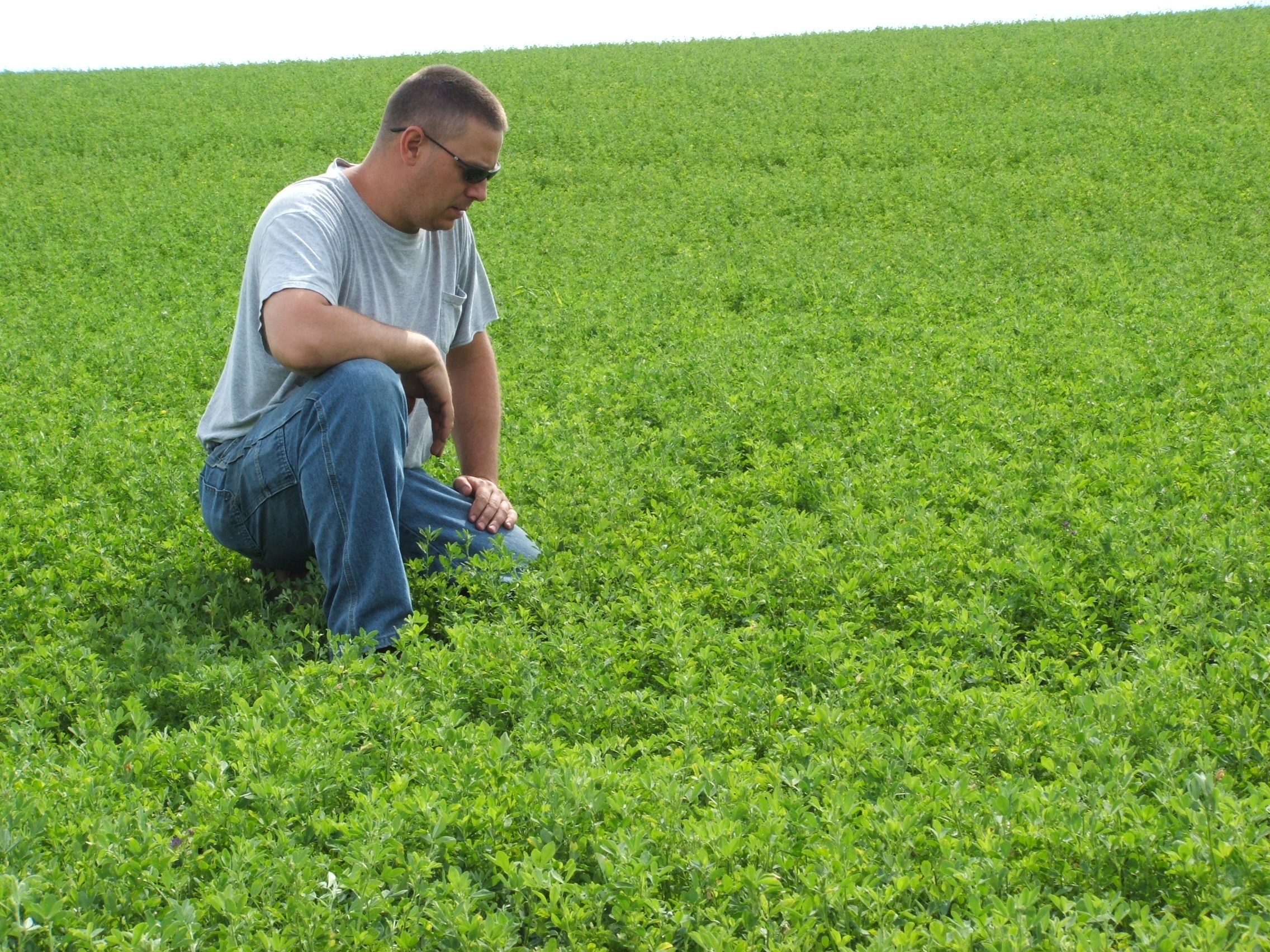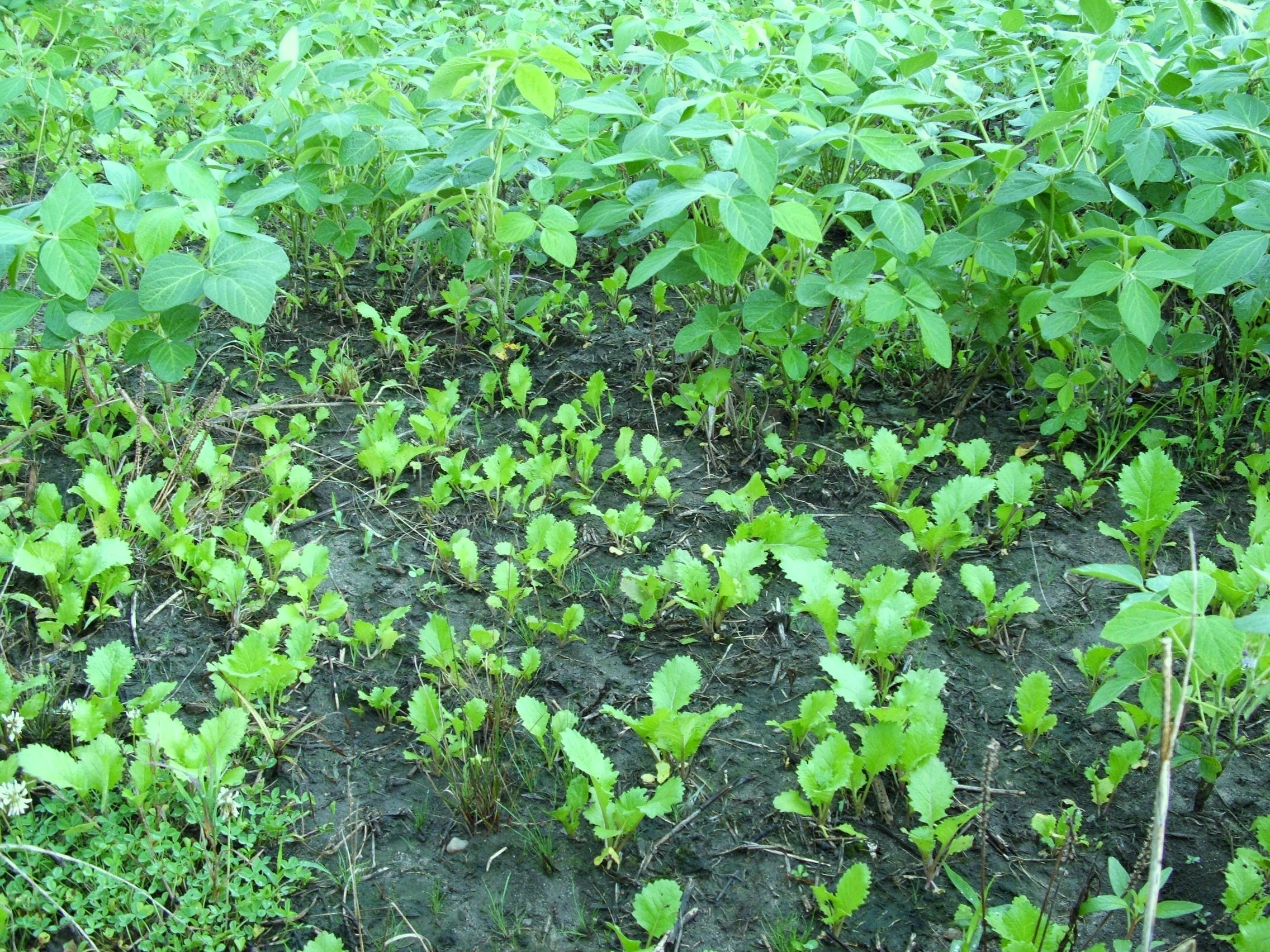Hunt 365 August-Fall Food Plot Questions (A version of this article is published in the August 2016 issue of Iowa Sportsman)
Q1. How do I compete with the farmer’s alfalfa field next door? No matter what I plant, the deer won’t leave the alfalfa for my food plots. My friends can plant all sorts of plots and they all get hit. Why aren’t my food plots attractive?

I don’t know of a food plot that can compete head to head with lush alfalfa. However, the alfalfa will eventually get old or go dormant making other food sources more of an attractant. Low hunting pressure is key.
A1. I really think this is the most misunderstood thing about food plots. How can one food plot variety work so well for one hunter…and not work at all for someone else? The answer is not always what we want to hear. The questions are always what blend/brand are you using? Where did you buy it? Did you fertilize? These are rarely the issues. So, let’s get back to the actual specifics of the question. I have yet to find a food plot that will compete head to head with a field of alfalfa. If the alfalfa gets old and the plants start becoming woody; you might have a chance. If the alfalfa takes some really hard frosts and starts to go dormant it becomes less attractive too. About the only things that can ruin an alfalfa field is hunting pressure, having it go dormant, or it gets old. Food plot attractiveness is always relative to what is available to the local deer herd. If you have prime alfalfa in the area, that will pull the lion share of deer. How then do we “compete” with a food source this attractive?
The first strategy is to put as little pressure on your deer as you can. Hopefully surrounding hunting pressure will eventually “push” deer to your farm as the season wears on. Try planting green plots like blends of appin turnips, dwarf essex rape, and winter rye. Eventually when the deer disperse throughout the fall or hunting pressure moves them around your plots will become attractive. If this is a recurring event in your hunting experience year after year, try planting grain crops like soybeans or corn next spring…they will eventually outcompete preferred green crops like alfalfa when the temperatures get cold. Finally, if you can’t compete with a crop like alfalfa, try establishing an alfalfa plot of your own. Fall is a great time to establish a perennial plot. I’ve had pretty good luck mixing 30/70 clover and alfalfa seeds. Grazing or forage alfalfa varieties work best for food plots! If you don’t have a way to bale or cut the alfalfa, it probably won’t work out for you very well…a trick that sometimes works is making the plot small enough that the deer will keep it mowed for you! Although it has nothing to do with food plotting, establishing superior habitat and bedding cover on your hunting grounds is a way to combat a preferred food source across the fence line!
Q2. When planting my fall food plots, can I lime and fertilize at the same time I plant clover, brassicas, or winter rye? What are the steps in establishing a fall green plot?
A2. To establish a fall green plot, follow these simple steps. 1. Till or work the ground until a majority of the soil is exposed. 2. Spread seed, fertilizer (if needed), and lime (if needed) all at the same time. 3. Bury the seed by dragging, lightly discing, or any other method that gets the seed into the ground. The bigger the seed, the deeper you bury. For small seed like clover or brassicas, ¼ inch to ½ inch is good. 4. If you have access to a cultipacker or roller, you can pack the ground but this step is not mandatory. For a fall green plot throughout the Midwest, the last 2 weeks of August into the first two weeks of September will usually work. Try to time your planting with rain in the forecast.
Q3. Where would be the best place to plant a food plot? I hunt in hilly country with ridges, side hills, and bottom grounds. Where is the best place to plant my food plots in hilly country?
A3. This is a great question? Why? Because in many, even most cases, location has more to do with the success of a food plot than what is planted in it or how good it looks. When planning food plots in country with ridges and valleys, the biggest issue I always have is being able to hunt with steady winds. Ridge tops have the steadiest winds…but many times ridge tops also have the poorest soil. Find a ridge top with good or decent soil and that’s a good place to start. Another truly awesome place to plant an interior plot is on a bench at the point of a ridge. The flat part of the bench usually offers good soil and winds can be consistent if the bench is large enough. Bottom fields can be great because they offer some of the most fertile soils; but they can be very hard or impossible to hunt if they are small and/or surrounded by ridges because of swirling winds. Bottom fields can work great late season during a gun season because you can hunt out of blinds farther away from the action making swirling winds less of an issue. A food plot you plan to hunt does you absolutely no good if you can’t get to it or leave it at the end of the hunt without bumping deer. It comes down to some basic considerations: Access to and from the plot comes first. Next, you must be able to hunt the plot with steady winds. Finally, fertile soil will make growing your plot possible. Combine all three—that’s where you plant your food plots.
Q4. Is it worth the effort to put in a watering hole on my property? If I was going to put one in, where would be the best place to put it for hunting?
A4. It is not always worth the investment in time and money to put in watering holes. If you assess your property and close surroundings and find that there are already plenty of water sources in the vicinity, adding your own water hole might just be low on your priority list. However, adding a watering hole directly adjacent to an interior plot that allows deer to get up out of their beds in the afternoon and immediately water can almost always pay off. These watering holes don’t have to be much, just a small pool of water will do. An easy way to create a watering hole is by damming up a ditch and lining the “hole” with clay or some type of poly liner. Location is more important than how the thing looks. Put simply, think of location in this way—if deer can they will travel from bedding, to watering, to transition area (interior plot), to their major food source (exterior plot) and in that order. And lastly, remember that watering holes are only really good during periods of dry and hot weather most commonly associated with southerly winds…so plan you hole and stand for southerly winds!
Q5. My perennial clover plot is full of weeds…so are my brassicas. Any suggestions?
A5. If you want to save your clover plot, you can use weed specific herbicides to save it. To kill grass in clover, my favorite herbicide is Fusilade DX but many others exist. Clethodim is another good choice for grass control. If you are trying to kill broadleaf weeds in clover my favorite choices are Raptor and Pursuit but they can be very expensive for the food plotter. If broadleaf weeds aren’t too bad, a good mowing might set the weeds back. Grass herbicides will also work well in a brassica plot, but I haven’t found a good broadleaf killer that won’t harm my brassicas. If your clover plot is too far gone, a great way to save the plot is to till under the clover and plant a brassica plot. Clover is great at fixing nitrogen which brassicas need to grow well. By tilling under the clover, you beat back the weeds and offer a nitrogen rich seed bed for a new brassica plot. Rotating from clover to brassicas is a great strategy when clover plots run their course. Till under the clover in early to mid-August…wait two weeks…then plant your brassicas. If you want to spray your clover/weed plot first, spray with glyphosate herbicide, wait a week, till under, and plant your brassicas a couple weeks later.
Q6. I want to broadcast brassicas over my corn and/or soybean food plots. When do I do this and do I need to add fertilizer?
A6. Overseeding a grain plot like soybeans or corn can work great to extend the life of the food plot and to continue with a green plot once the grain has ripened (like with soybeans). In this way, the plot will have both a green food source (the brassicas) and a grain source in the same food plot. Brassicas are a good choice for this but I wouldn’t rule out adding in some winter rye. Brassicas need moisture and nitrogen to grow good both at germination and after. If overseeding, you need to do your planting when sub-surface soil moisture is adequate and right before a good rain. Adding nitrogen is usually necessary, so much so that I always add nitrogen when using brassicas when overseeding…about 60lbs/acre is a good rule of thumb. I overseed my soybeans just as they start to turn yellow in late August or early September keeping in mind sub-surface moisture and timing with a rain. Overseeding corn is much harder when using a spreader unless you seed by hand. The same rules apply when overseeding corn as with soybeans.

Overseeding brassicas into soybeans requires adequate moisture and nitrogen. Without one or the other and it is a waster of your time. These appin turnips look good coming up in soybeans because they have both.
Q7. What is your favorite fall planted food plot?
A7. My favorite fall planted food plot to hunt over is without a doubt a blend of winter rye, appin turnips, and dwarf essex rape seed. Hands down, this simple and inexpensive blend has given me more successful hunts and more lush green food plots to hunt over than any other green plot for fall hunting. Sure, alfalfa might be more attractive, but establishing and maintaining alfalfa as a food plot can be very difficult. I’ve seen more times than I can count when a clover plot will burn out in summer leaving me with a lack luster plot come fall. But a late summer/early fall seeding of the above blend has almost never let me down. Seed at a rate of 25 to 30lbs/acre winter rye, 3lbs/acre appin turnips, and 3lbs/acre dwarf essex rape. Planting around the third or fourth week in August usually works pretty good and timing your planting with rain in the forecast is a good idea as well. Adding high nitrogen fertilizer will help the brassicas grow, 60lbs/acre nitrogen and 30lbs/acre potash will work just fine!
This August, as with most Augusts on my farm, I will be planted the winter rye, appin turnips, and rape blend in many of my interior and small food plot. August is also a great time to fertilize perennial plots of clover and alfalfa with a potash heavy fertilizer. August is also a great time to start/finish creating those entrance and exit routes to and from your stand sites. I like to spray my trails in the timber with glyphosate making entrance and exit quiet and scent free.
In September, I’ll cover preparing for early season archery hunting.
